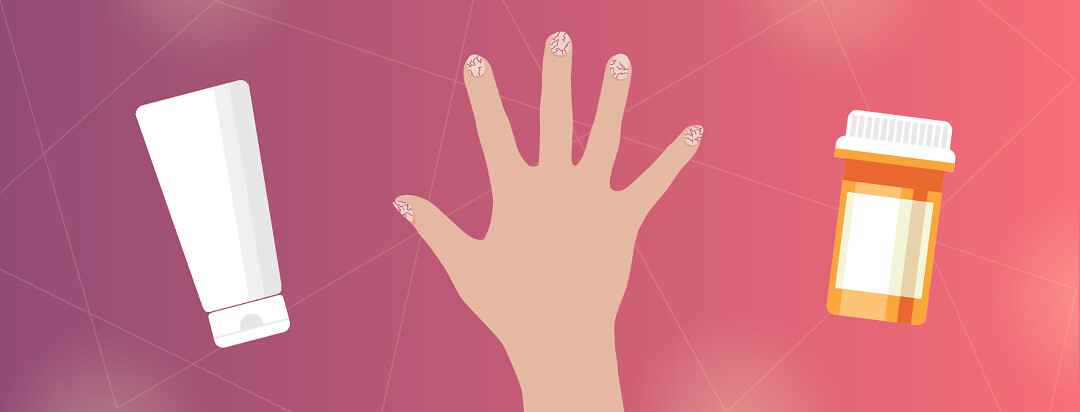Treatment Options for Nail Psoriasis
Reviewed by: HU Medical Review Board | Last reviewed: April 2025 | Last updated: April 2025
If you have psoriatic arthritis (PsA), you are at risk for developing nail psoriasis. Nail psoriasis is very common in people with PsA and psoriasis. In fact, 80 to 90 percent of people with PsA will develop nail psoriasis. And over half of people with plaque psoriasis will develop nail psoriasis.1,2
Nail psoriasis causes symptoms such as:1,2
- Pitting (dents in the nail)
- Discoloration
- Changes in the nails, such as thinning and crumbling
Nail psoriasis symptoms are often hard to predict and can vary from person to person. People also may respond differently to treatments. But there are several possible treatment options.1,2
Types of treatments for nail psoriasis
While there is no cure for nail psoriasis, there are treatments that can help manage symptoms and improve the appearance of nails. These include:1,2
- Topical treatments – Creams or ointments that are applied directly to the nails
- Oral medicines – Pills or capsules prescribed by a doctor to help control PsA symptoms. These are typically systemic drugs that treat the body as a whole.
- Medicine injections – Medicines delivered into the nail area by injection
- Phototherapy – Exposing the nails to ultraviolet light
- Laser therapy – Exposing the nails to a high-powered laser beam
- At-home nail care – Keeping the nails trimmed and clean
Topical treatments
Topical treatments are usually recommended for people who have mild nail psoriasis and no signs of severe PsA or plaque psoriasis. Topical drugs are generally applied 1 to 2 times a day and have relatively mild side effects.1,2
The most effective way to use topical treatments is to target where the nail psoriasis is located. This is because some treatments work better for nail bed psoriasis, while others are better for nail matrix (the area where the nail starts to grow) psoriasis.1,2
Topical treatments may include:1,2
- Steroids
- Calcipotriol – A treatment derived from vitamin D
- Tazarotene – A treatment derived from vitamin A
Oral medicines
Systemic drugs can improve the symptoms of nail psoriasis. However, they are generally prescribed only for people with severe cases of nail psoriasis or severe PsA or plaque psoriasis along with nail symptoms.1,2
Systemic treatments include:1,2
- Methotrexate
- Cyclosporine
- Apremilast
- Retinoids
- Biologics
Medicine injections
For more severe cases of nail psoriasis, medicines can be injected directly into the skin around the nail(s). Examples of these medicines include:1,2
- Steroids
- Methotrexate
Your dermatologist will give you the injection. Injections are usually given every 4 to 6 weeks. But ask your doctor how often you may need injections for your nail psoriasis.1,2
Phototherapy
Phototherapy is another treatment option for nail psoriasis. It is also known as light therapy. Phototherapy uses certain wavelengths of light to target and reduce inflammation, slow down the rapid growth of skin cells, and help with symptoms.2,3
There are different types of phototherapy. The most common ones for nail psoriasis include:2,3
- Ultraviolet B (UVB)
- Psoralen plus ultraviolet A (PUVA)
To be effective, experts recommend phototherapy sessions 2 or 3 times a week. Ask your doctor what they recommend for you. Common side effects include redness, mild stinging, itching, and freckles in the treated area.2,3
Laser therapy
Laser therapy is a newer treatment option for nail psoriasis. Laser therapy may help stimulate the body's natural healing processes, encouraging healthier and more normal nail growth. But more research is needed to understand how laser therapy might help with nail psoriasis.1,2,4
A pulsed dye laser (PDL) may be used for nail psoriasis laser treatment. Laser therapy for nail psoriasis should be performed by a trained healthcare professional, typically a dermatologist. They will assess your nails and determine the most appropriate type of laser and treatment plan.2,4
Side effects of laser therapy can include redness, swelling, and discomfort in the treated area. Talk with your doctor about whether laser therapy is right for you.4
At-home nail care
At-home nail care can help manage nail psoriasis symptoms. Here are some simple tips:2,5
- Keep nails short and neat. Trim your nails often to keep them short and neat. This can help prevent snagging and reduce the risk of injury.
- Leave cuticles alone. Cutting or pushing back your cuticles can injure the skin or lead to infection.
- Clean your nails gently. When cleaning your nails, use a gentle nail brush and mild soap. Avoid harsh chemicals or aggressive cleaning, as these can irritate the nails.
- Moisturize regularly. Apply a moisturizing cream or ointment to your nails and cuticles. Keeping the nails hydrated can help reduce brittleness and prevent splitting.
- Avoid trauma. Be gentle with your nails to avoid trauma. Avoid picking at, biting, or forcefully removing any loose or detached nail parts.
- Protect your nails. Wear gloves when doing activities that involve prolonged exposure to water or chemicals, such as washing dishes, cleaning, or gardening. This helps protect your nails from damage.
Other considerations
Nail growth is slow, and so is the response to nail psoriasis treatments. Many times, these treatments are combined with other treatment methods for better results. Talk with your doctor about which treatment methods may be right for you.1
Before beginning treatment for nail psoriasis, tell your doctor about all your health conditions and any other drugs, vitamins, or supplements you are taking. This includes over-the-counter drugs.

Join the conversation